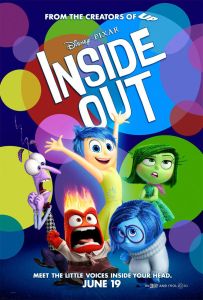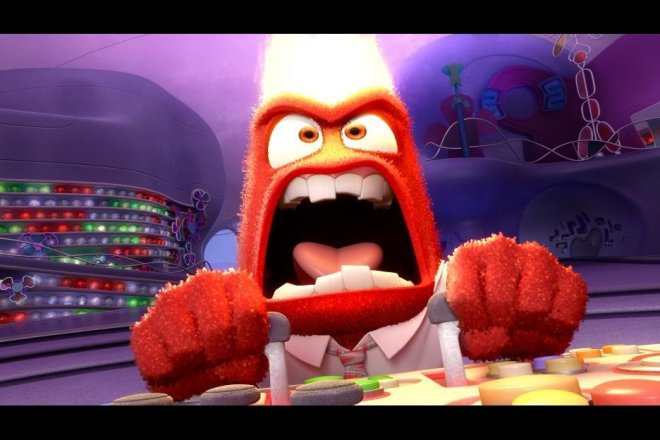Pete Docter’s creative Pixar classic helps explain the complex workings of our mind to kids and adults alike.
 As adults, we use stories to explain to our kids how the world works. We have fables that teach kids etiquette, or why the planets revolve around the sun, or why we celebrate holidays. Pixar has managed an incredible feat (and it’s hardly the first time) by creating an entire ecosystem of ideas, mechanics and colors to help explain the most complicated aspects of our minds.
As adults, we use stories to explain to our kids how the world works. We have fables that teach kids etiquette, or why the planets revolve around the sun, or why we celebrate holidays. Pixar has managed an incredible feat (and it’s hardly the first time) by creating an entire ecosystem of ideas, mechanics and colors to help explain the most complicated aspects of our minds.
“Inside Out” is a movie about emotions and filled with them, but it’s really a portrait for who we are and how we function. Across their 15 films, Pixar has made a good handful of sheer classics, and “Inside Out” is among them. But Pete Docter’s film is groundbreaking because it may be the first to reach us on such an intimate, fundamental level.
What goes on inside your head? That’s the first question “Inside Out” asks and it’s a question that starts at birth. Riley (Kaitlyn Dias) is born, and with her first waking thought is Joy (Amy Poehler). Joy is a bright yellow sprite with short blue hair and eyes as big as her heart. She presses a button inside baby Riley’s mind and makes her smile. As Riley grows, more emotions emerge to work together and compete for control of Riley’s central control panel. First is Sadness (Phyllis Smith), a round blue ball of depression who literally brings down anything she touches. Fear (Bill Hader) is a skinny purple bug dressed in plaid helping Riley avoid tripping on cables or getting into trouble. Disgust (Mindy Kaling) is a stylish green drama queen averse to broccoli. And last is Anger (Lewis Black, naturally), a short red hot head in business casual attire who loves traffic, talking back to dad and complaining about San Francisco pizza.
For each memory and moment in Riley’s life, a colored ball coded to each emotion is created with a brief video clip memory, stored in “headquarters” during the day and then shuttled off to a massive array of shelves signifying long term memory. There, little sanitation workers dispose of phone numbers, U.S. presidents and more to make way for newer memories. Meanwhile, a small collection of “core memories” defines the islands of personality that make up Riley (if psychologists have said that our traits are in some way “connected”, Pixar has animated that idea literally). When Sadness accidentally turns one of Joy’s core memories blue, the two scramble to fix it and end up separated from headquarters and the ability to make Riley happy or sad. It all coincides with Riley’s disappointing move away from Minnesota to California and gradually leaves her interests, personalities and feelings crumbling away.
The factory-like mechanics of “Inside Out” are not unlike the Scream factory Docter envisioned in “Monster’s Inc.”, in which our emotions and how we process them keep the world moving. But Docter and co-director Ronaldo del Carmen have fun with every interaction and every moment of a human’s life. Not one line or image passes in front of Riley’s eyes that does not dictate a quick-witted reaction from one of our five little balls of emotions. It’s a movie that literally makes good on the expression that someone’s emotions have taken over. In a dinner table conversation between Riley and her parents, her father’s own team of workers launch into a war room, and putting his foot down has all the gravity of turning two keys to launch a nuclear sub.

And yet thematically, “Inside Out” feels closest to “Toy Story”. The anthropomorphic emotions have given their lives to making Riley happy and creating memories that shape who she is, and as she grows into becoming a teenager, her moods and her need for memories that made her a joyful kid are no longer needed. Joy and Sadness come across Bing Bong (Richard Kind), Riley’s discarded imaginary friend now wandering the far reaches of her mind hoping to one day be remembered.
Often without much exposition, Docter helps convey through colors and cleverly constructed puns (the arrival of a “train of thought”) and analogies the inner workings of the mind from dreams, the subconscious and abstract thought. There’s an incredible sequence that plays with the film’s animation worthy of one of Pixar’s daring animated shorts, in which abstract ideas transform Joy and Sadness into surreal, cubist shapes and eventually two-dimensional drawings. The sequence works as a goofy action set piece, but kids and adults alike can understand the external real world implications these actions have on Riley’s mind.
Some of Docter’s most poignant ideas are perhaps a bit more common than the film’s ingenuity and perceived originality give it credit for: sadness as much as happiness shape who we are and what we remember, and as we grow, even our emotions grow more complex. But it’s not the surface level emotions and ideas that make “Inside Out” such an incredible tearjerker. It’s the complete package of vivacious animation, exuberant humor and sheer imagination that help us better understand these feelings and make this film so human both inside and out.
4 stars
 The real heist of “Ocean’s 8” is how they managed to fool us into thinking this was something new. Gary Ross’s film is effectively a remake of Steven Soderbergh’s “Ocean’s 11,” but with a gender-flipped cast. And instead of a radical experiment, a fresh point of view on a spectacularly male franchise, “Ocean’s 8” is an incredibly safe, unassuming, if amusing, retread with some slightly different faces.
The real heist of “Ocean’s 8” is how they managed to fool us into thinking this was something new. Gary Ross’s film is effectively a remake of Steven Soderbergh’s “Ocean’s 11,” but with a gender-flipped cast. And instead of a radical experiment, a fresh point of view on a spectacularly male franchise, “Ocean’s 8” is an incredibly safe, unassuming, if amusing, retread with some slightly different faces.

 Ava DuVernay truly wants “A Wrinkle In Time” to be the most glorious, inspiring movie you’ve ever seen. She wants you – yes you, little black girl who has never seen herself represented on screen before – to believe in yourself so you can bring light into the world and be a force for positive change. DuVernay believes this so strongly that she’s even dressed Oprah in space age chain mail, glued-on diamonds and a glittery lip gloss that looks like it cost half of the movie’s $100 million budget so that Oprah can do what Oprah does best and make it seem like she’s speaking directly to you.
Ava DuVernay truly wants “A Wrinkle In Time” to be the most glorious, inspiring movie you’ve ever seen. She wants you – yes you, little black girl who has never seen herself represented on screen before – to believe in yourself so you can bring light into the world and be a force for positive change. DuVernay believes this so strongly that she’s even dressed Oprah in space age chain mail, glued-on diamonds and a glittery lip gloss that looks like it cost half of the movie’s $100 million budget so that Oprah can do what Oprah does best and make it seem like she’s speaking directly to you. As adults, we use stories to explain to our kids how the world works. We have fables that teach kids etiquette, or why the planets revolve around the sun, or why we celebrate holidays. Pixar has managed an incredible feat (and it’s hardly the first time) by creating an entire ecosystem of ideas, mechanics and colors to help explain the most complicated aspects of our minds.
As adults, we use stories to explain to our kids how the world works. We have fables that teach kids etiquette, or why the planets revolve around the sun, or why we celebrate holidays. Pixar has managed an incredible feat (and it’s hardly the first time) by creating an entire ecosystem of ideas, mechanics and colors to help explain the most complicated aspects of our minds.